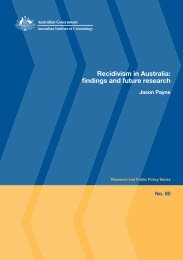Crime and victim surveys - Australian Institute of Criminology
Crime and victim surveys - Australian Institute of Criminology
Crime and victim surveys - Australian Institute of Criminology
Create successful ePaper yourself
Turn your PDF publications into a flip-book with our unique Google optimized e-Paper software.
<strong>Crime</strong> <strong>and</strong> Victim Surveys<br />
carried out twice were averaged. To ensure greater comparability, all rates were<br />
calculated for respondents living in cities with more than 100 000 inhabitants.<br />
Urban Victimisation Rates across the World<br />
By way <strong>of</strong> introduction to the subject, we will first present urban <strong>victim</strong>isation<br />
rates for four different types <strong>of</strong> crime <strong>and</strong> the overall rates <strong>of</strong> the six global<br />
regions.<br />
The overall five-year <strong>victim</strong>isation rate is highest in Africa where three <strong>of</strong><br />
every four citizens were <strong>victim</strong>ised. In Ug<strong>and</strong>a, for instance, 96 per cent <strong>of</strong> the<br />
citizens were <strong>victim</strong>ised at least once. In Asia, less than half the population was<br />
<strong>victim</strong>ised. Rates for contact crimes (such as violent crimes <strong>and</strong> robbery) are<br />
highest in Africa <strong>and</strong> South America. In Rio de Janeiro, Buenos Aires, Kampala,<br />
Tunis, Dar es Salaam <strong>and</strong> Cairo one in every three citizens had fallen <strong>victim</strong> to<br />
such crimes. The distribution <strong>of</strong> car related crimes (car theft, theft from cars <strong>and</strong><br />
car v<strong>and</strong>alism) is strikingly different: the highest rates are in the New World<br />
countries <strong>and</strong> Western Europe.<br />
To gain insight into the social background <strong>of</strong> crime, all respondents were<br />
asked whether they were satisfied with their financial situation. Respondents in<br />
the industrialised countries <strong>and</strong> Asia were substantially more satisfied than those<br />
in Africa, South America <strong>and</strong> Eastern Europe. On the face <strong>of</strong> it, high rates <strong>of</strong><br />
<strong>victim</strong>isation by contact crimes <strong>and</strong> personal thefts go together with high<br />
proportions <strong>of</strong> people who feel economically deprived. This relationship was<br />
confirmed by multivariate analyses <strong>of</strong> national <strong>victim</strong>isation rates. By contrast,<br />
car-related crimes tend to be higher in nations with developed economies where<br />
more people own cars. These findings lend support to the theoretical notion that<br />
crime rates are partly determined by the economic problems <strong>of</strong> (potential)<br />
<strong>of</strong>fenders <strong>and</strong> partly by the provision <strong>of</strong> criminal opportunities by (potential)<br />
<strong>victim</strong>s.<br />
From these findings the conclusion can also be drawn that <strong>victim</strong>isations by<br />
crime can no longer be seen as rare events in most urban parts <strong>of</strong> the world. This<br />
is even true for <strong>victim</strong>isation by crimes <strong>of</strong> violence. A majority <strong>of</strong> all families in<br />
urban areas are struck at least once by crime in the course <strong>of</strong> five years. The<br />
experience to be criminally <strong>victim</strong>ised has become a statistically normal feature<br />
<strong>of</strong> the life <strong>of</strong> families in an urban setting. In all countries <strong>victim</strong>isation rates are<br />
highest among young adolescents. Most adolescents living in the largest cities <strong>of</strong><br />
the world must be regarded as streetwise survivors <strong>of</strong> crime <strong>and</strong> its<br />
repercussions.<br />
If the large majority <strong>of</strong> the population has been a <strong>victim</strong> in recent years, the<br />
impact <strong>of</strong> <strong>victim</strong>isations cannot be adequately assessed by comparing <strong>victim</strong>s<br />
with non-<strong>victim</strong>s. Nearly all citizens, whether formally defined as <strong>victim</strong>s or<br />
non-<strong>victim</strong>s, are affected in one way or the other by criminal <strong>victim</strong>isations. In<br />
addition to cross-sectional analyses, the impact <strong>of</strong> crime upon the <strong>victim</strong>’s<br />
attitudes must therefore be measured by comparing the attitudes <strong>of</strong> the public in<br />
low crime regions with those <strong>of</strong> the public in high crime regions. The ICS dataset<br />
<strong>of</strong>fers unique opportunities to carry out precisely such comparisons. Using the<br />
ICS dataset, relationships between <strong>victim</strong>isations <strong>and</strong> attitudes can be analysed at<br />
125















